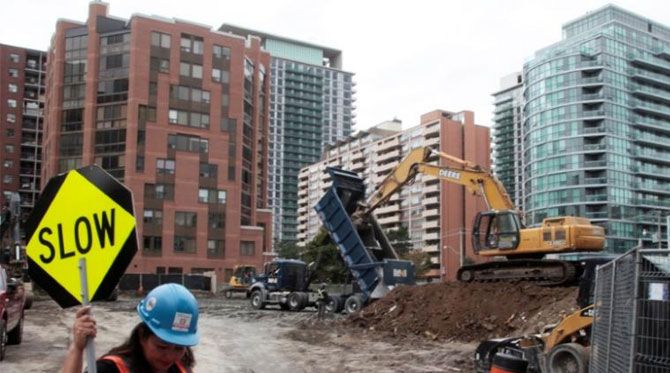Diwesh Sharan, of Asian Development Bank, says beside the PPP model and viability gap funding, there is a 3rd option - value capture - to raise funds for India's ambitious infrastructure projects.

IMAGE: Areas of high development potential abound, including railway stations, new city developments, and metro rail systems. Photograph: Chris Helgren/Reuters
India has a huge infrastructure gap. To narrow it, the government is targeting infrastructure investment of over $1 trillion during the Twelfth Five-Year Plan -- equivalent to half of India's gross domestic product.
Given the limited budget space, the government’s strategy has focused on encouraging private funds into infrastructure through various forms of public-private partnerships (PPPs), mainly based on user fees. This has shown mixed results so far.
Currently, user fees seldom cover the cost of building or even operating major infrastructure projects. India's relatively low per capita income of around $1,600 limits the fee level.
The government’s initiative to support the viability of such projects through one-time grants -- known as viability gap funding -- also faces budget constraints.
There is another option to fund India’s infrastructure needs - value capture. This is a way of commercialising and capturing the increased value of land and facilities after infrastructure has been developed nearby, or based on a credible plan to build the infrastructure.
India has begun to capitalise on the opportunities provided by this method of funding infrastructure. It needs to expand these efforts, particularly in urban areas, to emulate the transformative impact that the approach has had on the infrastructure of other countries in the region.
In defining value capture, we should bear in mind that infrastructure creates value -- and not just for its users. Indirect benefits of new or upgraded infrastructure include increasing land values -- traditionally viewed as a windfall to lucky individuals or businesses nearby.
These indirect benefits can be marshalled through taxes and fees on existing land-owners or by selling or leasing land, with the proceeds ploughed back into the infrastructure project to improve its financial viability.
Selling or leasing seems to be the preferred mode, as people are more willing to pay for an increase in value than to be charged for a windfall later on.
At a greenfield project -- one sited on land that has not been developed -- extra value can be generated from land price increases.
Brownfield projects -- on land that has previously been developed -- can generate gains from the unexploited commercial potential of the land and any existing facilities.
In India, railway stations located in the heart of cities have been identified by the central government as having high potential in this respect.
New transit routes have traditionally been the most reliable way of spurring and capturing land prices in nearby areas. Hong Kong’s profit-making mass transit railway was funded in this way.
And five decades of successful railway development in Tokyo has relied at least in part on the selling and leasing of development rights on sites surrounding the railway lines.
The People’s Republic of China has shown that it can apply to entire cities as well - and to stunning effect.
Starting with Shenzhen, world-class infrastructure has been built in several cities, using funds generated by local companies which were set up to lease land on a long-term basis, leveraging changes in land use as well the new infrastructure. Though not a recurrent source of funding, this approach has generated unprecedented levels of financing in cities across China.
India has made a good start on value capture. Nearly half of the revenue from Hyderabad’s PPP metro project is expected to come from capturing the enhanced value of surrounding land through property development.
Beginning with the Delhi International Airport, India has built a number of world-class airports quickly across the country as PPPs, with partial support from appreciation in land value and commercialisation of various airport facilities.
India needs to build on this success by taking up similar pilot projects using value capture where the method has not yet been tried. Areas of high development potential abound, including railway stations, new city developments, and metro rail systems.
A priority area could be to embed value capture in flagship programmes such as smart cities development, where states and urban bodies require huge amount of funds to build or upgrade city infrastructure.
This could transform the country’s infrastructure landscape, especially in the urban areas. With its strong track record, India is capable of quickly replicating the successful pilot projects.
There may be no better time for India to embrace value capture. The business environment is conducive to scaling it up. Commercialisation of infrastructure is gaining public acceptance.
There is a well-developed policy and institutional framework for PPPs, and a strong focus on mobilising additional funds to comply with the Fiscal Responsibility and Management Act 2003.
The sooner this happens, the better. How quickly the first few projects are completed will determine the scale and timing of a transformation that India urgently needs.
Diwesh Sharan is deputy director general of the Asian Development Bank's South Asia Department











